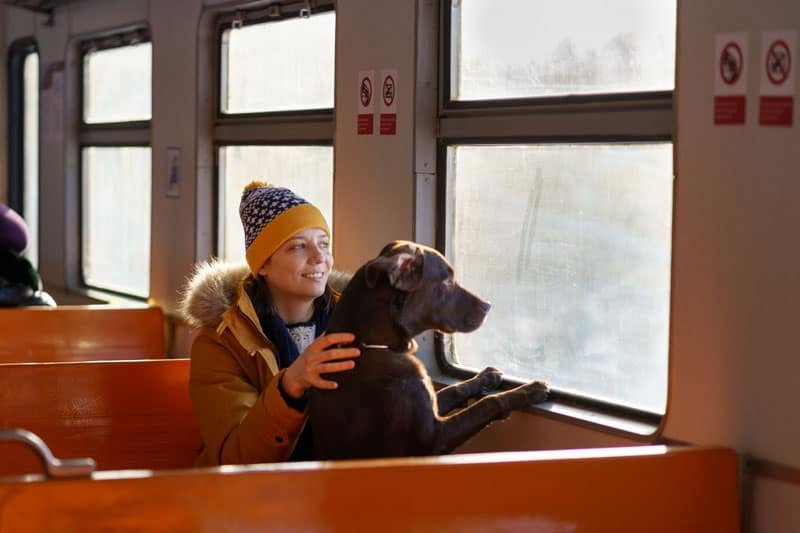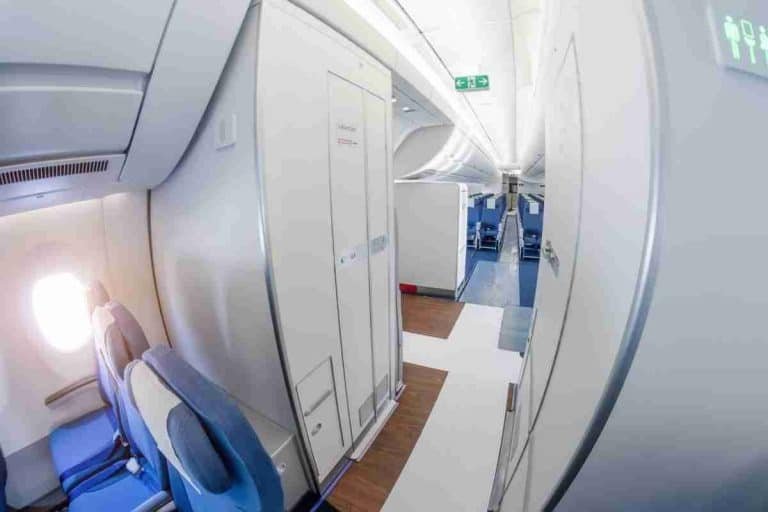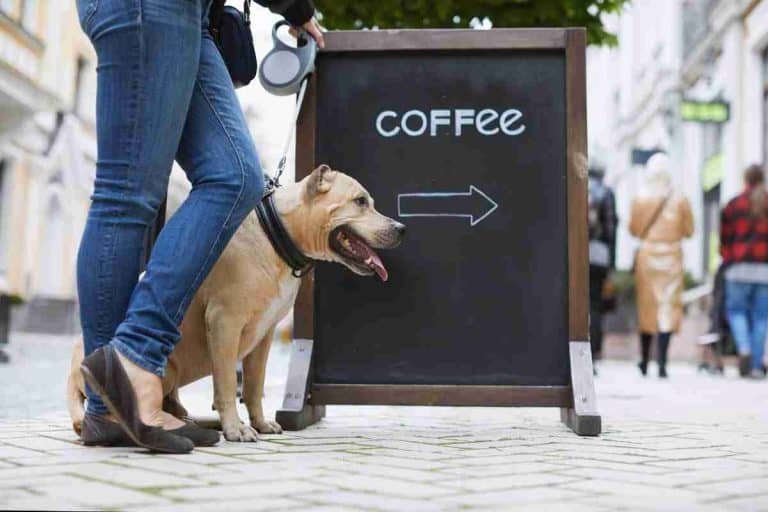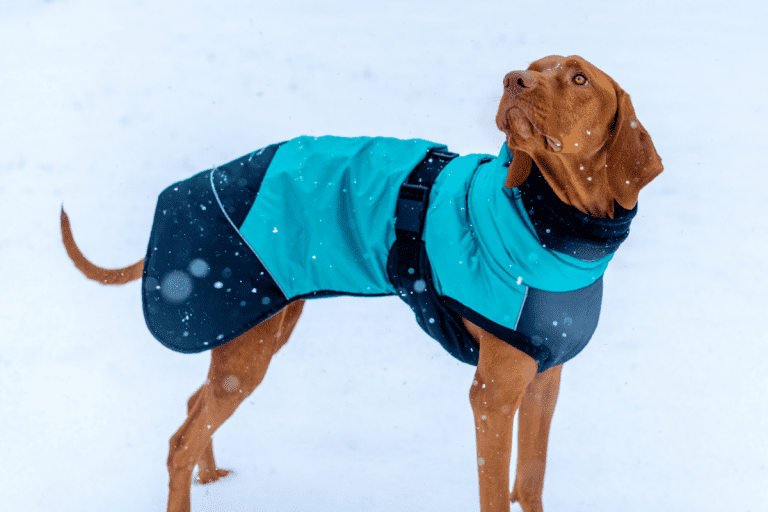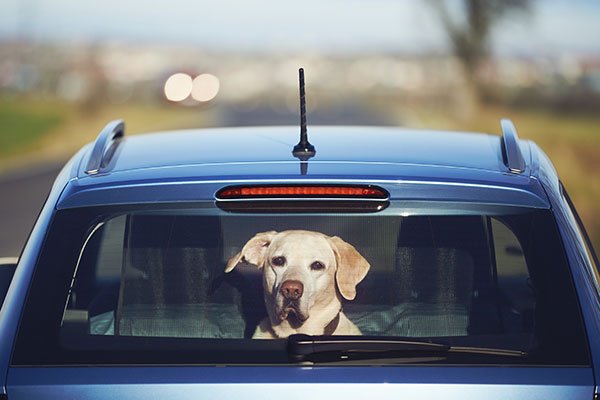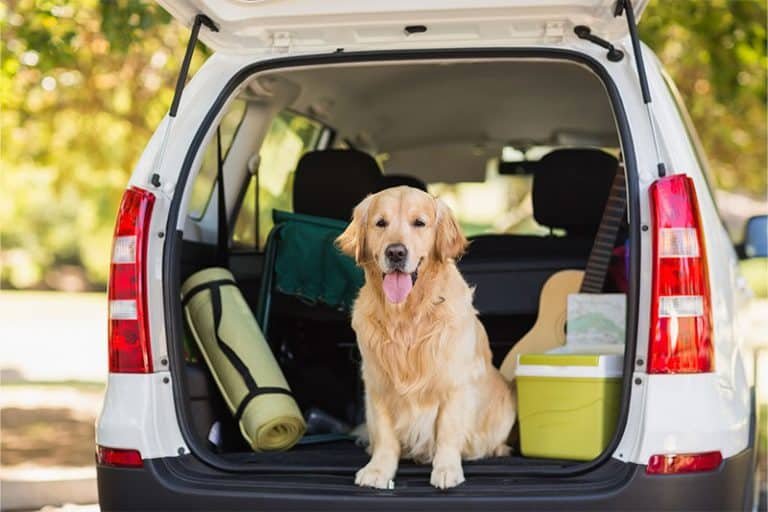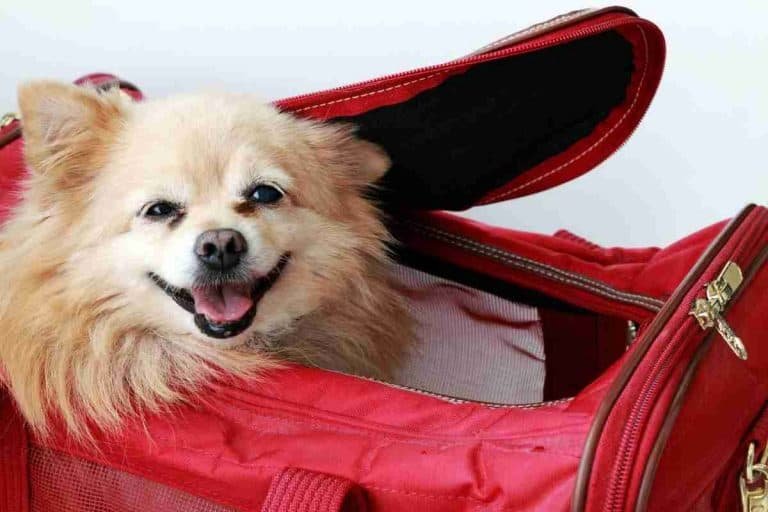Traveling With Your Dog by Train: Essential Tips, Rules & Packing Checklist
Affiliate Disclaimer: As an affiliate, we may earn a small commission when you make a purchase from any of the links on this page at no additional cost to you!
Last Updated on October 15, 2025
Traveling With Your Dog by Train gets simpler when policies, limits, and packing stay precise. Many rail lines cap pets, enforce weight limits, require approved carrier dimensions, and apply a seven-hour rule. One missed detail can trigger denied boarding or extra fees. This post delivers essential tips, rules, and a packing checklist so a dog-friendly train trip stays smooth and compliant.
Readers get clear answers on route eligibility, reservations, pet fees, and designated pet cars. Pet owners learn how to choose an approved carrier, prepare vaccination records and microchip details, and navigate check-in and boarding. On-board etiquette, calming strategies, long-trip and emergency planning, plus international variations round out the essentials. A concise packing checklist prevents last-minute surprises and keeps the journey on track.
Plan your dog-friendly train trip
Start by confirming a carrier, route availability and reservation rules before booking. Many rail operators limit pets to short-distance services and require advance booking. Pack a passport-style folder with vaccination records, a recent photo, and a copy of the carrier dimensions. Choose a carrier that meets measurements for under-seat or lap storage and that the dog tolerates on short practice rides. Bring collapsible food and water bowls, a harness, and odor-proof cleanup supplies. For gear guidance relevant to longer pet journeys, see essential dog travel tips and gear for road trips. Reserve the pet spot as soon as seats open; many lines limit pets per service.
Which routes and services typically allow dogs
Regional and commuter trains often accept small pets on short trips. Long-distance and high-speed services frequently exclude pets or limit them to select cars. Amtrak-style intercity carriers commonly permit small dogs if the trip stays under the operator’s time limit. Always verify the specific service’s pet policy before purchasing tickets.
Key limits and restrictions to know (weight, trip length, seating)
Expect a weight limit that includes the carrier, usually around 20 pounds on many carriers. Trips longer than a set duration may be prohibited. Operators may require pets to remain in a carrier at all times and sit in designated seating zones. Fees and maximum one-pet-per-passenger rules apply. Book early and confirm carrier dimensions to avoid denied boarding.
Rules for service animals and emotional support pets
Service animals trained to perform tasks receive broader access and cannot be charged a pet fee. Emotional support animals do not qualify as service animals on most rail systems and must follow standard pet rules. Carry documentation for trained service animals and understand the operator’s comfort and safety checks.
When a train isn’t the right option
Avoid train travel for very large breeds, brachycephalic dogs, or animals with severe separation anxiety. If confinement, extended stops, or lack of onboard pet relief makes the journey unsafe, choose driving, a pet transport service, or alternate routing. If uncertain, consult a veterinarian and explore other travel modes before finalizing plans.
How to book and reserve a spot for your dog
Booking a spot for a dog requires more than buying a ticket. The owner should verify the carrier rules, weight and dimension limits, and breed restrictions before reserving. Many carriers limit pets per train and require advance notice to guarantee a cabin or seat option. Bring clear vaccination records and identification when checking in. For practical gear and comfort tips that pair well with train travel planning, consult essential dog travel tips and gear for road trips.
Adding a pet during online or phone booking
When booking online, look for a dedicated “add pet” option in the booking flow. The system will typically ask for breed, weight, and carrier dimensions. If the site lacks that option, call the carrier’s reservations line. Have exact measurements and the dog’s temperamental notes ready. Request a confirmation number or email that explicitly lists the pet reservation. If the dog travels in an approved carrier under the seat, confirm whether that occupies a passenger’s footwell or requires its own seatbook entry. For phone bookings, ask the agent to read back the pet details and to place a special service notation on the reservation. Save screenshots or emails proving the pet was added. Arrive at the station early to allow staff time to verify the reservation and inspect the carrier.
Fees, reservation limits and ticketing rules
Expect a pet fee per dog or per carrier on many services. Fees vary by route and class of service. Some trains allow only one small pet per passenger. Larger dogs may need checked or specialized accommodations and higher fees. Confirm whether the pet fee is refundable if the carrier denies boarding, and ask about transfer or connection rules for multi-leg trips. Ticketing rules can require a printed or digital ticket for the pet, or a notation on the owner’s ticket. Know weight and size caps: exceeding them may require buying a second seat or reserving a special space. If traveling with emotional support or service animals, review separate documentation requirements. Carry receipts for any paid pet reservation and note any reservation limit that might prevent boarding when capacity fills.
Pet Release/Indemnification forms and signatures
Many carriers require a pet release or indemnification form that shifts liability to the owner. Read the form carefully before signing. It commonly asks for owner contact details, emergency vet authorization, and an affirmation that vaccinations are current. If a minor or third party travels with the dog, verify who must sign and whether notarization or a written permission letter is necessary. Keep one printed copy of the signed form and one digital copy accessible. If the carrier offers a pre-filled form online, complete and upload it before arrival. Retain proof of submission and confirmation emails. For owners traveling with service animals, check whether the form applies; some carriers exempt recognized service animals from indemnity requirements.
What to do at unstaffed stations or when rules are unclear
At unstaffed stations, plan to handle verification and boarding yourself. Print all documents, including reservation confirmations, vaccination records, and signed indemnity forms. Arrive extra early to load the carrier and secure a safe boarding spot. If station staff are absent and rules remain unclear, contact the carrier’s customer service or dispatch phone number immediately. If the conductor appears unsure, present all paperwork and request a written note of any refusal. If denied boarding without a clear policy, document the interaction with photos and record call reference numbers. Consider alternate services if the carrier’s policy remains ambiguous; ask about refunds or rebooking options. When in doubt, keep the dog secured in an approved carrier and out of aisles to reduce conflicts. For urgent on-route questions, the conductor or onboard manager can usually clarify policy and make temporary accommodations.
Choosing the right carrier and preparing documentation
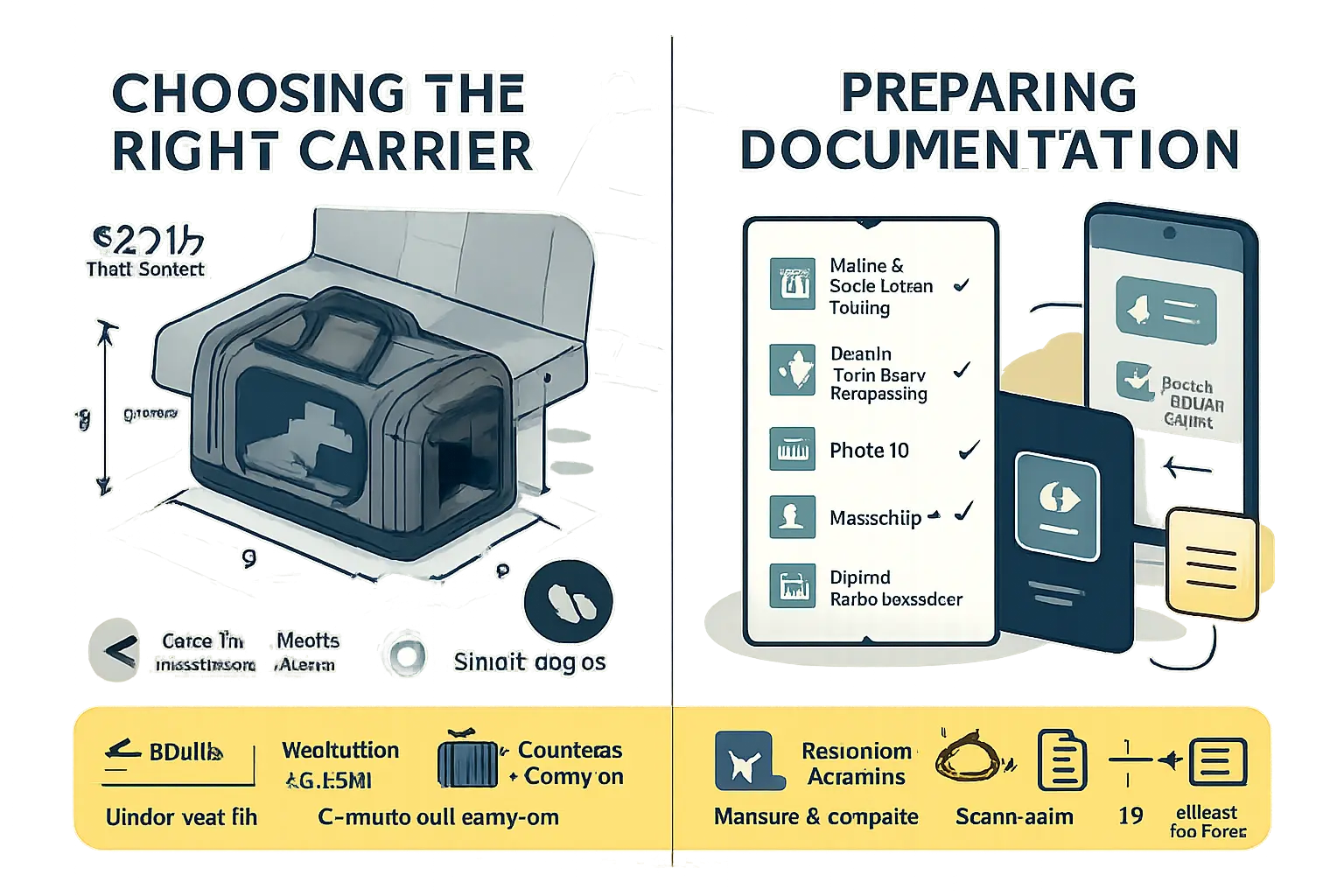
The carrier choice and paperwork determine whether a train trip with a dog goes smoothly. Select a carrier that matches the train operator’s pet policy, fits the space available on board, and keeps the dog comfortable during long runs.
Before booking, verify the operator’s size, weight and reservation limits for pets. If the train requires reservations for animals, secure the pet spot early. Pack both paper and digital copies of rabies and vaccination records, a short health certificate if the route crosses states, and a leash-plus-collar with ID.
Prepare a compact travel kit: a foldable water bowl, a waste bag supply, a small towel, a familiar-smelling blanket, and a few treats to reward calm behavior. Label the carrier with the dog’s name and the owner’s contact details. Scan all documents and store them in a phone folder for quick access.
For additional gear ideas and practical packing tips that apply to multi-modal travel, consult this essential dog travel tips and gear guide. Confirm documentation requirements with the carrier and bring originals when required. A final CTA: call the train operator 24-48 hours before departure to reconfirm pet rules and placement allowances.
Approved carrier dimensions, types and ventilation requirements
Different train services set different approved carrier dimensions. Because rules vary, measure the carrier while it is empty and compare those dimensions to the operator’s published limits. Choose a carrier that allows the dog to stand, turn and lie down comfortably.
Carrier types fall into three useful categories:
- Soft-sided carriers: Lightweight, compressible, and often accepted where under-seat placement is required.
- Hard crates: Rigid, secure, and better for larger dogs or longer journeys when permitted by the operator.
- Backpack and sling carriers: Good for small dogs and short segments, but check weight and ventilation rules.
Ventilation matters. Approved carriers must provide airflow on at least two sides and use durable mesh or ventilated panels. Avoid carriers with one-sided ventilation only. Include a non-slip mat and a removable washable liner for hygiene.
For comparisons and crate features tested for travel durability, see this review of best dog crates for car travel. Always prioritize secure closures and escape-proof zippers or latches.
How carriers count toward carry-on limits and placement rules
Many passenger railways treat a pet carrier like a single piece of carry-on luggage. That classification means the carrier may need to fit within a seat footprint, under a seat, or be held on a passenger’s lap. Some operators count the carrier toward the passenger’s total carry-on allowance.
Common placement rules include:
- Keep the carrier in the passenger’s seating area or directly at their feet.
- Do not block aisles, vestibules, doors or emergency exits.
- Some services prohibit carriers in specific cars, like dining or quiet cars.
Train staff may ask passengers to reposition a carrier during boarding or to secure it so it cannot slide. For routes that connect to flights or other carriers, note that placement norms differ. Review air and rail rules when planning multi-leg trips. For cabin rules and how carriers interact with seating, this page about airline cabin pet policies offers useful parallels to check against.
When booking, request advice on exact placement and bring straps or non-slip pads to stabilize the carrier on board.
Required IDs, vaccination records and microchip tips
Carry these documents for every trip: proof of rabies vaccination, a current vaccination summary, a basic veterinary health certificate when required, and a photo ID showing the dog’s face. Regulations can change by route and by state, so verify requirements ahead of time.
Microchip best practices:
- Confirm the microchip number and that the registration lists current contact details.
- Bring a copy of the microchip enrollment paperwork and list the microchip number on the carrier label.
- If the dog lacks a chip, consider getting one well before travel to allow proper registration.
Keep a compact folder with originals and photocopies of all paperwork. Store scans in cloud storage and on a phone for quick retrieval. If a long-distance move or interstate trip is involved, ask a vet about a health certificate dated within the operator’s required window.
For additional context on which pets commonly travel and related documentation tips, review this post on dogs you can take on a plane. A CTA: before departure, make one final document checklist and place copies both inside and outside the carrier.
Day-of-travel procedures and boarding steps
On travel day, follow a concise pre-boarding routine to reduce stress for both dog and owner. Complete a quick health check, confirm the pet reservation and fee, and pack the day bag with water, treats, a leash, and cleanup supplies. Label the carrier with name, destination, and a contact number. If the dog takes medication, place doses in an easy-to-reach pouch.
Arrive relaxed and ready to show documents. Keep digital copies of vaccine records and the reservation on a phone, plus one printed set. Use a comfortable, airline-style carrier that meets size rules for the chosen service. Secure the carrier so it won’t slide or tip during boarding.
During the boarding sequence, maintain a low-energy approach. Offer a calm treat and a short walk before entering the station. If a pet relief area exists, use it; otherwise plan a last-minute break outside the station. A final quick grooming—wipe paws and eyes—can prevent surprises during conductor checks.
For general packing and gear recommendations, see Essential dog travel tips and gear for road trips. Confirm the pet reservation early; many services cap animals per train.
Recommended arrival time and station check-in process
Plan to arrive earlier than usual when traveling with a dog. For most intercity services, 60 to 90 minutes gives enough time to complete pet-specific tasks. Busy terminals require extra time for restroom stops, pet relief, and quick paperwork reviews.
At check-in, approach the staffed counter or kiosk and state the pet reservation immediately. Present the printed or mobile reservation and the pet fee receipt. Keep vaccination records and any required health certificates handy. If the service requires carrier inspection, open the carrier briefly while the dog remains calm inside so staff can confirm size and ventilation.
Use dedicated pet relief areas before check-in when available. If lifting a large dog into a station vehicle or onto a platform becomes necessary, follow safe lifting steps: bend at the knees, keep the dog close, and use a harness with a handle. For guidance on safe handling of larger dogs, consult 5 steps to safely lift a large dog into a car.
Final tip: notify staff of any behavioral concerns so they can assist. Missing a pet check-in can delay boarding or lead to denied travel.
Boarding, seating options and designated pet cars
Boarding usually follows a staged process. Staff may direct pet owners to board during a specific window to minimize disruption. Owners should keep dogs inside carriers until staff permits otherwise.
Seating and pet policies vary widely. Some services allow small dogs in carriers placed under the seat. Others provide designated pet cars or compartments with clear rules. If pets ride in a designated car, owners must secure carriers and avoid occupying aisle space. When seats are reserved, choose spots near doors for faster access during station stops.
Place the carrier on a non-slip mat and strap it if possible. If the dog will be out briefly under leash, keep distance from other passengers and always use a short leash. For longer journeys, rotate comfort items and offer water at stops to prevent dehydration.
For carrier selection, measure carefully and pick a sturdy option with good ventilation. See recommendations on travel carriers and crates at Best dog crates for car travel in 2023. Owners should reserve appropriate seating early, as pet-friendly spots sell out.
Interacting with conductors and showing paperwork
Conductors enforce safety and pet rules. Approach interactions calmly and be prepared. Have the reservation, vaccination records, and any required health certificate within easy reach.
When a conductor asks for documentation, hand over the printed confirmation first, then show digital copies if requested. Present vaccination records and proof of microchipping if the service requires them. If the dog has special medical needs, carry a veterinarian note that explains medications and dosages.
Label the carrier clearly with the dog’s name and contact information. If the conductor inspects the carrier, keep the dog calm with brief, quiet reassurances and pause treats until after checks. Answer questions directly and honestly; this speeds the process.
Keep backup copies of documents in a zip pouch and on a smartphone. For more on documentation and carrier rules across transport modes, consult Airlines that allow large dogs in cabin for examples of how carriers and paperwork requirements can differ. A polite, organized approach helps prevent delays and keeps the journey smooth.
On-board care, comfort and etiquette
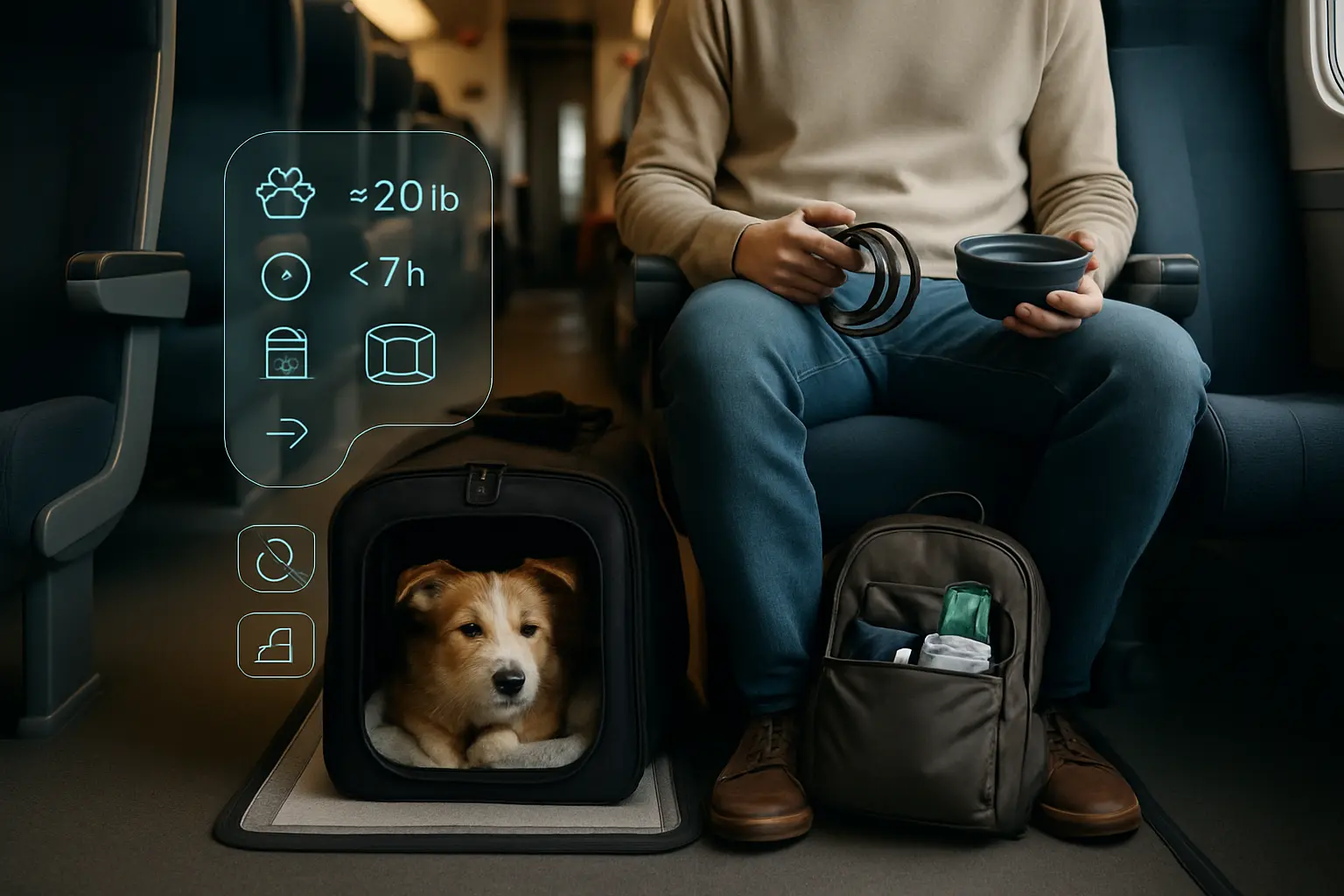
On-board care means balancing the dog’s needs with respect for other passengers. Train trips often last hours. Pack items that keep a dog comfortable and contained. Use a soft mat, absorbent pad, a familiar blanket and favorite toy to reduce stress. Choose a carrier that fits the train’s size limits and provides ventilation and quick access. Bring a travel-sized first-aid kit and copies of vaccination records in a waterproof folder. Confirm pet fees and seating rules before boarding so the dog stays in permitted areas. For practical gear recommendations, consult essential dog travel tips and gear for road trips. Keep care items in an easy-to-reach bag under the seat or in overhead storage if allowed. Staff may ask to see documentation; present it calmly. A short CTA: check the carrier dimensions against the train’s policy before departure.
Proper carrier placement and when your dog must stay inside
Place the carrier under the seat or at the passenger’s feet where the dog feels secure. If the train requires a carrier during transit, never leave the carrier in the aisle or on a seat. The carrier must lock or fasten reliably and allow the dog to stand, turn, and lie down comfortably. For longer journeys, choose a carrier with breathable mesh and a reinforced base to avoid collapse during movement. If an attendant requests the dog remain inside the carrier because of congestion or safety, comply immediately. When the carrier sits on the floor, secure it so it won’t slide during acceleration or braking. For ideas on sturdy travel crates that adapt to vehicle travel, see best dog crates for car travel in 2023. If a dog shows signs of distress while confined, pause at the next allowed stop to assess comfort and offer water, not food, until settled.
Feeding, water, potty solutions and restroom etiquette
Feed light meals before boarding to reduce motion discomfort. Offer small amounts of water regularly, not large gulps, to prevent nausea. Carry a spill-proof bowl and a measured water bottle to control intake. Bring absorbent potty pads and a portable litter option or grass pad for small dogs. Walk the dog during scheduled station stops; arrive early to give the dog a chance to relieve itself before boarding. For guidance on handling bathroom needs while traveling by air or long distances, reference how do dogs go to the bathroom on a plane, which adapts well to rail travel. Clean up immediately and bag waste for proper disposal. If space permits, place a fresh pad under the carrier to protect flooring and reduce odors. Maintain a feeding and potty schedule that aligns with stop times to minimize accidents on board.
Calming anxious dogs and minimizing barking or odors
Reduce anxiety with pre-trip conditioning and short practice rides. Use a comfortable blanket with the dog’s scent and a few chew-safe toys. Natural remedies, such as pheromone sprays or pressure wraps, can ease nerves for many dogs; consult a veterinarian before using supplements. Train simple stay and quiet commands before travel so the dog responds to cues in busy environments. If barking starts, remove the dog from stimulating areas and give a quiet, short chew to redirect energy. Manage odors with odor-neutralizing pads placed under the carrier and washable liners. For behavioral tips on travel anxiety, consult 9 natural ways to remedy your dog’s travel anxiety. If anxiety remains severe, discuss sedative options with a vet; avoid sedatives without professional guidance, as they can affect balance and breathing at speed.
Being considerate to fellow passengers (leash, hygiene, space)
Respect other passengers by keeping the dog leashed when out of the carrier and close to the owner’s seat. Use a short leash to limit the dog’s movement in aisles and near doors. Never allow a dog to occupy a seat or invade another passenger’s space. Maintain hygiene: trim nails before travel, wipe paws after station walks, and ensure the dog is free of strong-smelling grooming products. If the dog sheds heavily, keep a lint roller handy and sweep up before disembarking. Offer to move the carrier if a neighbor has allergies, provided it remains within policy. For context on managing vocal or disruptive pets in transit, see what happens if my dog barks on a plane. Polite communication goes far—apologize immediately for any inconvenience and take corrective action without delay.
Managing long trips, emergencies and special situations
Handling multi-leg journeys and the seven-hour rule
When planning multi-leg rail trips, the traveler must treat the itinerary as a single journey. Many rail operators enforce a seven-hour rule for in-cabin pets, so total continuous travel time matters. Book each segment with the carrier and confirm pet reservations for every leg. If one segment exceeds the allowed time, the carrier can refuse boarding for the entire itinerary.
Reserve seats that minimize transfers and provide easy access to station exits. Allow ample transfer time; tight connections increase stress and refusal risk. Keep the dog in a carrier that meets the carrier’s dimensions and tag the carrier with contact details and reservation information.
Contact customer service before purchase to verify pet policies for each leg. If an operator allows pets only on specific trains, ask staff to note the reservation. For general packing and trip-prep advice for road and multi-modal travel, consult essential dog travel tips and gear for road trips. Book early to secure the limited pet spots many carriers offer.
Motion sickness, medication and pacing food/water
Motion sickness shows as drooling, lip licking, pacing, yawning, or vomiting. The safest step is a veterinary consult before travel. A vet can prescribe anti-nausea medication and recommend the correct dose. Test any medication on a short trip well before the main journey.
Pace feeding to reduce nausea. Offer a light meal four to six hours before departure. Avoid fatty or new foods right before travel. Provide small amounts of water at intervals, not large gulps, and offer water at scheduled stops.
Non-pharmaceutical strategies help. Use gradual acclimation: short rides building to longer ones. Bring familiar-smelling bedding and a favorite toy. For natural calming and motion remedies, the post on making car rides enjoyable for a motion-sick pup offers actionable tips. Never sedate without veterinary approval, and avoid sedatives for brachycephalic breeds.
Emergency planning: locating vets and handling delays
Prior planning reduces risk when delays occur. Before departure, map veterinarians and emergency clinics along the route. Save addresses, phone numbers, and online directions to the phone and in printed form. Include the dog’s vaccination records, medical history, and microchip details in both digital and paper formats.
Pack an emergency kit: basic first aid, extra medication, bottled water, food, leash, collapsible bowl, towels, and a recent photo of the dog. If a delay leaves the dog on a platform or at a station, staff may provide a safe area. Request assistance immediately and document the interaction.
For stress management during an emergency, natural calming techniques can help dogs settle while waiting for professional care. See ideas at 9 natural ways to remedy your dog’s travel anxiety. Keep emergency contacts visible on the carrier and have a clear contingency plan for rerouting or overnight stays.
Alternatives for larger dogs or unexpected refusals
When a carrier rejects a dog for size or other reasons, the traveler should have alternatives ready. Options include driving portions of the trip, hiring a pet transport service, or using a pet-friendly bus or ferry that accepts larger animals. Boarding near the departure station for the missed segment can work for short-term needs.
Prepare a crate or harness system suited for alternate transport. A sturdy travel crate that secures well in a vehicle eases transitions and meets many ground-transport requirements. For crate selection, see the review of best dog crates for car travel.
If a refusal occurs at the station, remain calm and request written clarification of the policy. If possible, escalate to a supervisor while keeping the dog comfortable and secure. Book alternative transportation immediately and notify companions or accommodation of revised arrival plans.
Other services, international notes and further resources

For readers of Traveling With Your Dog by Train: Essential Tips, Rules & Packing Checklist, this section covers services and resources beyond booking and basic rules. It focuses on how regional commuter lines differ, what to expect when traveling abroad, where scenic tourist trains fit in, and which official pages to check before departure. Use these pointers to match the right service to the dog’s temperament and the trip’s length.
Regional and commuter rail differences and pet-friendly examples
Commuter and regional rail systems usually set simpler, localized pet rules than national operators. Many allow small dogs inside secure carriers during off-peak hours. Some permit leashed, well-behaved dogs on platforms and certain cars; others restrict pets to dedicated sections.
Owners should confirm whether reservations, fees, or time-of-day limits apply. Regional services often enforce carrier size and behavior standards rather than complicated health paperwork. When choosing a route, consider frequency of stops and access to outdoor relief areas.
For practical gear recommendations and travel-focused tips that help on shorter regional trips, consult the resource on essential dog travel tips and gear for road trips. Those suggestions translate well to commuter rail trips and can simplify carrier selection, leash management, and short-trip toileting plans.
Traveling by train abroad: common policy variations
International rail operators vary widely. Some European national systems allow leashed dogs for a low fare, while others require a carrier or muzzle for certain breeds. In many countries, local commuter lines differ from high-speed and overnight trains.
Cross-border trains may add paperwork requirements: vaccination records, pet passports, or specific transport crates. Customs and agricultural checks can require extra time when entering a different country, so owners should factor delays into connections.
Language barriers can complicate last-minute questions. Owners should save translated snippets of key policy terms, and carry clear copies of vaccination certificates. For broader guidance on airline and carrier differences that often mirror international transport rules, see the overview on airlines that allow dogs in cabin. That page highlights carrier size and documentation issues that often arise when crossing borders by any transport mode.
Scenic tourist trains and special pet-friendly services
Scenic tourist trains sometimes offer relaxed pet rules, designed for day trips rather than long-haul transport. Some operators welcome leashed dogs in open-air observation cars or on short excursions. Others run dedicated “pet-friendly” departures with limited capacity.
When using tourist services, confirm seating arrangements and whether outdoor viewing areas remain accessible with a dog. Owners should prioritize crate comfort and stability during the ride. Bring absorbent pads, a familiar blanket, water, and non-spill bowls.
If a crate requirement exists, ensure it meets size and durability standards for the route. Practical crate choices and ways to make carriers travel-ready appear in the review of best dog crates for car travel in 2023: a comprehensive review. Those crate features often apply directly to tourist-train carriage rules and short excursion comfort.
Quick links and official policy pages to check before you go
Always verify operator pages before traveling. Check the train company’s pet policy, permitted carrier dimensions, any required tickets or fees, and rules about leashes or muzzles. Also review platform access, station toilet options, and whether reservations are mandatory for pets.
For cross-border trips, consult the national customs or agricultural authority for pet entry rules. Carry digital and paper copies of vaccination records and microchip details. Bookmark the train operator’s policy page and a local emergency vet lookup for the route.
For practical advice on securing crates or carriers during transit, see the step-by-step ideas in 5 ways to secure a dog crate in car. Before travel, click through official policy pages and the linked resource to confirm equipment and documentation needs. If anything seems unclear, contact the operator directly and save the reply.
Pre-trip packing checklist and quick FAQs
Essential items to pack
Owners should assemble a compact kit that keeps a dog comfortable, healthy, and contained. Pack items in a clear bag and label it. Bring duplicates of anything critical, such as leashes and paperwork.
Carrier with absorbent lining, leash/harness, ID tags
Choose a carrier that fits the train’s size limits and allows airflow. Line it with absorbent pads and a familiar blanket. Include a sturdy leash and a harness for supervised walks. Attach visible ID tags with phone numbers and destination.
Vaccination records, signed release form, medications
Carry up-to-date vaccination records and any required release forms from the carrier company. Pack medications in original containers and a small pill organizer for doses during the trip.
Portable water bowl, treats, comfort toy and waste bags
A collapsible water bowl and measured water bottles keep hydration simple. Bring favorite treats and a comfort toy to reduce anxiety. Pack plenty of waste bags for stations and platforms.
Short potty pads, calming aids and clean-up supplies
Include a few short potty pads for emergencies, enzyme cleaner, and disposable gloves. If recommended by a veterinarian, add calming aids such as pheromone sprays or a Thundershirt.
For additional gear ideas, see essential dog travel tips and gear for road trips.
Common questions answered (quick-reference)
Can my dog sit on my lap or the seat? — No; must stay in carrier unless rules allow
Dogs must remain in approved carriers unless the carrier policy states otherwise. Crew may request the carrier stay closed during travel.
What if my dog needs to potty mid-journey? — Use scheduled stops or pads; ask crew
Plan scheduled stops at staffed stations. Use pads for short trips and ask crew about approved relief areas before departure.
How much does it cost? — Varies by route; check fare summary when booking
Pet fees vary by carrier and route. Review the fare summary during booking and factor fees into the total trip cost.
Are large dogs allowed? — Usually not; look for alternatives or special services
Most regular services restrict large dogs. Investigate freight, cargo, or specialized pet transport options if the dog exceeds limits.
CTA: Confirm pet policies, carrier size limits, and fees at booking to avoid surprises.
Summary
Traveling With Your Dog by Train: Essential Tips, Rules & Packing Checklist outlines how to verify route-specific pet policies, reserve a limited pet spot, and choose a compliant, comfortable carrier that fits under-seat dimensions. It details weight and time limits common to Amtrak-style services, required documents, and how to add a pet during booking so the reservation appears on the ticket.
The guide also covers day-of procedures, placement rules, conductor interactions, on-board etiquette, and care strategies for feeding, water, potty breaks, and anxiety. It closes with multi-leg and seven-hour-rule planning, emergency prep, international variations, and backup options for larger dogs. Strong next steps: reconfirm pet rules 24–48 hours before departure, label the carrier, and pack the checklist items in duplicate.
Key Takeaways
- Verify and reserve early: Confirm weight (often up to ~20 lb including carrier), trip-time caps (e.g., seven-hour limits), designated seating, and fees; add the pet to the booking and save written confirmation.
- Choose and acclimate the carrier: Ensure under-seat fit, ventilation on two or more sides, secure closures, and practice short rides; note it often counts toward carry-on limits.
- Prepare documentation: Carry rabies and vaccination records, health certificate if required, microchip details, photo ID, and any indemnification form—both printed and digital.
- Arrive prepared: Get to the station 60–90 minutes early, use pet relief areas, keep the dog in the carrier for boarding, and follow placement rules to avoid aisle blockages.
- Manage comfort on board: Feed a light meal 4–6 hours before, offer small water sips, plan potty breaks at stops, use calming aids if vet-approved, and minimize barking and odors.
- Plan for exceptions: Count total time across all legs, document interactions at unstaffed stations, and have alternatives ready for large breeds or unexpected refusals.
FAQ
- What size and time limits apply on Amtrak-style services? Many allow small dogs up to about 20 lb including the carrier and require trips under a set time limit. Policies vary by route, so verify before purchase.
- How do you add a dog to your reservation? Use the booking flow’s “add pet” option or call the reservations line with the dog’s weight and carrier dimensions, then request a confirmation showing the pet and fee.
- What documents should you bring? Bring rabies proof, a current vaccination summary, any required health certificate, microchip details, and the signed release if applicable—both printed and digital.
- How should feeding, water, and potty breaks be handled? Offer a light meal 4–6 hours before departure, give small water sips during travel, and use scheduled station stops or pads for relief, cleaning up immediately.
- Why might boarding be denied? Common reasons include exceeding weight/dimension or time limits, full pet capacity, missing paperwork, or a non-compliant carrier. Ask for written clarification and use a backup plan if needed.

